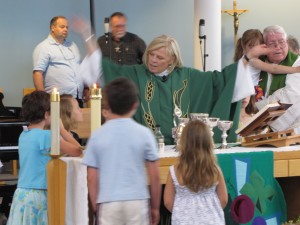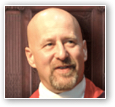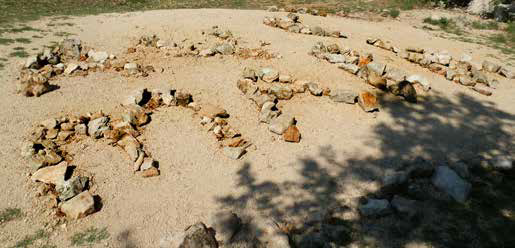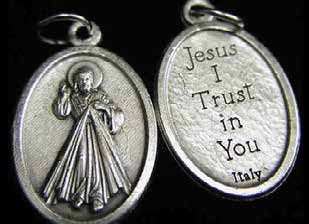By Amy Garland
The spirit of the story is always the same, but the specifics are all over the place.
You know The Exorcist? It happened at Saint Louis University.
It happened in DuBourg Hall. On the fourth floor, in a room that has been sealed off for years.
A light is kept on in the room, still. The door is only unlocked to change the light bulb. There's a bloody handprint on one of the walls. A giant cage.
No, it wasn't in DuBourg. It was Verhaegen Hall. It was the College Church basement. Jesuit Hall.
In hushed tones, upperclassmen tell the story to freshmen during their first days on campus, or maybe once the air turns cold in the fall. New employees hear about it, too, especially if they end up in one of the infamous locations.
A University legend at this point, the story includes its share of error, exaggeration and fabrication. Here is the real story.

A panel of experts about the exorcism of 1949 spoke at Pius XII Library last fall: Allen, Padberg, Waide and Stark. Photo by Michelle Peltier
Possession Obsession
Waide (A&S '73) has worked at Pius XII Memorial Library for 40 years and was the University archivist for more than two decades. He knows SLU history forwards and backwards. So it's a little unsettling when he begins the story of the 1949 exorcism by acknowledging, "There are dozens of versions of what happened."
Don't even think about consulting William Peter Blatty's 1971 book The Exorcist or the 1973 film it became. The version Waide puts the most stock in is Thomas B. Allen's Possessed: The True Story of an Exorcism, a historical account based on two primary sources: a detailed diary kept by Raymond Bishop, S.J., who assisted during the rite, and lengthy interviews with Walter Halloran, S.J., another assistant who was one of the last living eyewitnesses to the exorcism.
On a gray, stormy afternoon last fall, Allen visited Saint Louis University to headline "The St. Louis Exorcism of 1949" discussion hosted by University libraries special collections and the office of mission and ministry. Waide, John Padberg, S.J., a Jesuit historian and scholar, and Paul Stark, S.J., vice president for mission and ministry, rounded out the panel and provided historical and ecclesial context for the events of early 1949. A crowd of more than 700 spilled into the stacks at Pius Library, and the panel members held them in thrall as they recounted the story.
Tell the Truth and Shame the Devil
A self-proclaimed "Jebbie boy" with six years of Jesuit education in his past, Allen was a freelance writer in the early 1990s when he came across a brief note in a Washington Post gossip column about Halloran giving an interview about the exorcism to a Nebraska newspaper. Intrigued -- and thinking he'd pen something about it for the Washingtonian -- Allen started tracking down the Jesuit. He contacted him on Halloween, of all days, and the two ended up becoming friends.
"He was what the Irish call 'a solid man,'" Allen said. "And he never was certain about whether or not the boy was possessed."
As Allen tells it, Halloran's involvement in the exorcism came about almost by chance.
In 1949, Halloran was a Jesuit scholastic studying history at Saint Louis University. He also happened to be a driver for William Bowdern, S.J., then the pastor of St. Francis Xavier College Church. One night, Bowdern asked Halloran to drive him and another Jesuit to dinner at a home in a northwest St. Louis suburb. Halloran had no idea what he was getting into.
"He thought he'd be waiting outside, but when they pulled up to the house, Bowdern turned to him and said calmly, 'I'll be doing an exorcism. I want you to hold the boy down in case it's needed,'" Allen said.
What happened that night -- and for weeks afterward -- is still somewhat shrouded in secrecy.
What the Devil Really Happened?
In January 1949, a 13-year-old Maryland boy -- not the 12-year-old girl depicted in The Exorcist -- started experiencing strange, troublesome episodes: scratching sounds coming from the walls and floor of his room, the sound of water dripping, movement of a mattress and other objects. At first, his family thought he might have been plagued by the spirit of a recently deceased aunt, who had introduced the boy to the Ouija board. The family consulted physicians, psychiatrists and a minister from their Lutheran church. They grew desperate as the situation worsened.
Go to a Catholic priest; the Catholics know about this kind of thing.
"They go to Rev. Luther Miles Schulze, a Lutheran minister who happened to be greatly interested in the paranormal, as it was called at that time, and he said, 'Go to a Catholic priest; the Catholics know about this kind of thing,'" Allen said.
(Incidentally, Schulze later spoke at a meeting of a Washington, D.C., branch of the Society for Parapsychology about this case. That information made its way to the press, and the published Schulze interview led to the leaking of the exorcism story by Catholic sources. Studying at Georgetown at that time, William Peter Blatty read the story in the Washington Post and years later used it as inspiration for The Exorcist.)
On Schulze's advice, the family went to a local priest, Father E. Albert Hughes, who "gave them a bottle of holy water and candles and sent them on their way," Allen said.
Hughes later asked the archbishop of Washington, D.C., for permission to perform an exorcism on the boy. That attempt ended when the boy broke off a piece of a spring from the mattress he was strapped to and slashed Hughes "from shoulder to wrist," Allen said.
The boy's mother, a St. Louis native, suggested a change of scenery. After several incidents of scratches appearing on the boy's body without apparent cause, the word "LOUIS" emerged on his rib cage. The family took this as confirmation: They should take the boy to St. Louis.
The boy ended up staying in a house with a relative who had attended Saint Louis University. One of her professors was Father Bishop, who became one of several Jesuits to participate in the exorcism and kept the day-by-day account on which Allen's book is based. Bishop talked to his friend William Bowdern, S.J. After both men consulted with Paul Reinert, S.J., then president of Saint Louis University, and St. Louis Archbishop Joseph Ritter, all agreed that an exorcism would be performed according to the Roman Ritual. It was something that Bowdern, who was chosen to be the lead exorcist, knew little about.
"Father Halloran said the first thing Bowdern did was hit the books," Allen said. "He would have learned something about it while becoming a Jesuit, but there isn't much call for exorcism to the modern-day priest. But Bowdern was a veteran of World War II, he'd been in combat -- so he was a combination of a religious man who was very tough."
The process ended up taking more than a month, during which Bowdern fasted. Several priests, Alexian Brothers and family members participated in or witnessed the rite, which always began in the evening.
"The pattern was that the boy would act normally during the day, and then he would put on his pajamas and go to bed, and go into a trance and start screaming and yelling and acting wild," Allen said. In the morning, the boy apparently never remembered what transpired the night before.
The exorcism continued on almost a nightly basis, even though the boy seemed to be getting worse. The priests asked his family for permission to teach him about Catholicism and convert him as a way to strengthen the fight against the supposed demonic possession. As he got closer to conversion and making his first holy Communion, his episodes become increasingly violent.
On April 18, the day after Easter Sunday, the exorcism appeared to have succeeded. An entry from Bishop's diary reads: "Since Monday at 11 p.m. there have been no indications of the presence of the devil."
The boy left St. Louis several days later and went on to lead an otherwise normal life; he married around 1970, had children and never experienced anything like possession again, according to the Jesuits and Alexians who "kept track of him," Allen said.
None of the exorcism's eyewitnesses ever publicly revealed the details of the incident, out of respect for the boy's privacy. But in the words of Jesuit historian and scholar John Padberg, S.J., who also participated in the University's exorcism panel with Allen last October, "It's too good a story not to tell people about it!"
And so, it continues ...
Read more:



 Father Tadeusz Pacholczyk earned a Ph. D. in Neuroscience from Yale University. Father Tad did post-doctoral research at Massachusetts General Hospital/ Harvard Medical School. He subsequently studied in Rome where he did advanced studies in theology and in bioethics. He is a priest of the diocese of Fall River, MA, and serves as the Director of Education at
Father Tadeusz Pacholczyk earned a Ph. D. in Neuroscience from Yale University. Father Tad did post-doctoral research at Massachusetts General Hospital/ Harvard Medical School. He subsequently studied in Rome where he did advanced studies in theology and in bioethics. He is a priest of the diocese of Fall River, MA, and serves as the Director of Education at  Father Dwight Longenecker. "Welcoming Gays: How Do I Do That?" Patheos (Standing on My Head) (October 22, 2014).
Father Dwight Longenecker. "Welcoming Gays: How Do I Do That?" Patheos (Standing on My Head) (October 22, 2014).
